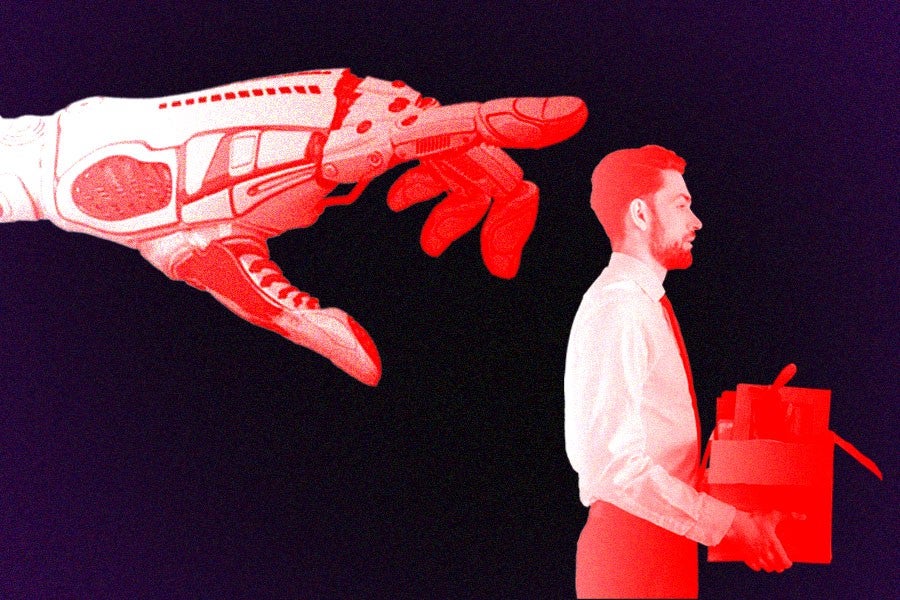Planning a new career move? How’s that resume looking? To make it competitive in today’s job market, you might want to think about adding a couple of competencies to that list of generic skills everyone includes.
For example: Alongside, “I thrive on pressure,” “I’m a committed team player” and “I relish new challenges when pushing the envelope under my own initiative,” consider throwing in, “I’m capable of making roughly a billion calculations per second.” It’s not a lie as such — it’s the estimated processing power of the human brain — but it’ll make you sound a lot more like the robot hire every employer seems to be looking for these days.
By now we’ve all been made aware of the automated apocalypse that’s on the horizon for our livelihoods. For the past two years, dystopic predictions have proliferated in the media about the extent to which AI and automated technologies will supplant human workers. Some estimates have suggested that a third of America’s workforce is at risk of replacement by machines by 2030 (just over a decade away!), along with 800 million jobs worldwide.
As you might expect, the manufacturing and service industries are particularly vulnerable to auto-usurpation. But it’s not just truck drivers being thrown under the bus in favor of self-driving vehicles, garment-industry workers being stitched up by full-service seamstress-bots, or postal workers being packed off to early retirement by Amazon’s all-conquering drone armada. Breakneck advances in machine learning mean that creative and intellectual fields, once thought ineffably immune to algorithms, are frequently being shown to be pre-programmable pursuits too.
Are you a writer of interesting articles for a super-smart lifestyle website? Well, bot-produced content is already a burgeoning industry. The Washington Post’s AI reporter Heliograf has filed hundreds of stories since it was introduced for the 2016 Rio Olympics, for example — and here’s an article about the rise of AI-written content that’s itself been written by an AI content generator — probably in, like, a nanosecond. It lacks a certain poise IMO, but nevertheless: Ouch.
Or are you a professional poet, perhaps? The demoralizing news is that computer-generated poetry seems to be emerging from its truly terrible adolescent phase and is now capable of dashing off the odd respectable stanza, even responding to imagery with what passes for imaginative insight.
An arranger of 18th-century three-part cantatas in the style of Johann Sebastian Bach? More bad tidings: DeepBach, an algorithm that does your exact job, has been able to fool panels of musicians and musicologists around 50 percent of the time into thinking that harmonies cranked out by Baroque-bot were arranged by a human composer.
Or are you a luminary in the field of leadership development? “I’m in leadership development,” says Dr. Linda Sharkey, co-author of business survival guide The Future-Proof Workplace, “and there’s all sorts of things happening with leadership development that are technology enabled, that make my job that much better. But if I’m not using them, I’ll become obsolete in my field.”
There really is no escape. Scarier still, forecasts that the mass disruption will have rippled through the workforce by 2030 might well be on the optimistic side. “It’s racing,” says Sharkey. In the year since her book was published, she says, “Technological change has exponentially increased.” Sharkey thinks that’s why we’re hearing a swelling chorus of tech-versus-human scare stories at the moment, which echoes a sense of, “Wanting to go back to the way things were — because it’s a change process that’s way too quick for people.” But, she says, not-too-reassuringly invoking Star Trek’s nightmarish army of tech-enslavers the Borg, “Resistance is futile. It’s here. And we’re never going back.”
So is it inevitable that we’ll all see our work prospects assimilated in the next five to ten years? Thankfully, as puny emotional organisms, we humans do possess some assets of value to employers that AI is unlikely to replicate for a long time to come.
“Our research shows that soft skills are going to become increasingly more important,” says Sharkey. “You can hire anybody and train them in a matter of months to do almost anything you want them to do,” she explains, describing the way we traditionally think of employment as a task-based, and therefore robot-friendly, enterprise. “But it’s much more difficult to train them to be collaborative, to work well with others, to play well in the sandbox, to want to learn. The ability to care, the ability to show empathy, to be curious — that’s the piece people need to think about as they move forward in their careers.”
Soft skills can beat software, then, in situations where empathy is called for. But how does that translate into wage-earning 9-to-5s in the real world? Sharkey highlights three broad sectors where she thinks human workers will be needed more than ever as technology revolutionizes our industries and public services.
The first is healthcare. Despite robo-docs’ proven potential for data- and task-based medical functions, such as diagnosing illnesses, “There’s an empathy in healthcare, and there’s a caring there, that only a human can provide. So those are going to be huge jobs of the future,” says Sharkey. Similarly, roles in education — teaching, coaching, mentoring — are likely to remain flesh-and-blood led because of their reliance on interpersonal skills.
If you’re not cut out to be a healthcare worker or a teacher, maybe think about learning a trade. Sharkey and her colleagues are already detecting a growing trend for, “Really small businesses that have a human connection with others and can provide fabulous customer service around stuff that people need.” Tradesfolk fit the bill perfectly as the embodiment of local, face-to-face operations. “Everybody needs an electrician; everybody needs a plumber — people who know what they’re doing,” says Sharkey.
Aside from being able to connect with clients at a personal level, a good tradesperson is instinctively able to adapt to new circumstances and improvise solutions to curve-ball problems — situational skills that lie far outside the comfort zone of the iterative approach to problem-solving taken by algorithms.
For those of us who can’t retrain, we can at least be optimizing our attitudes toward technology, so we end up being carried along with the tide, rather than trying to swim against it and becoming overwhelmed. “If you bury your head in the sand, you will get so lost. Even in a year, you won’t be able to catch up,” warns Sharkey. “You need to try it; you need to work with it. No matter how you cut it, there’s always someone, or some group of people, somewhere, who are monitoring the efficacy of that robot or the technological process.”
How to robot-proof your existing job, then? Aim to establish yourself as one of the machines’ human taskmasters in your chosen profession. You don’t have to learn to code or communicate in binary for that — but you do need to engage with new technology, even as its disruptions are being felt in your workplace. As Sharkey puts it, successfully adapting to the robot age, “is a matter of paying attention, being curious, staying on top of technology for your field, seeing which way it’s going and honing your interpersonal skills.”
Alternatively, you could try turning your hand to the one vocation even the most sophisticated artificial intelligence can’t hope to encroach on in a million years: Stand-up comedy.
Oh, wait…

